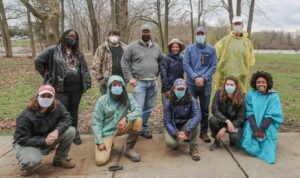Our March News to Us showcases important new research on environmental issues across Michigan. Read below for recent articles spotlighting studies on PFAS in Southeast Michigan rivers, the importance of freshwater biodiversity, climate impacts on Michigan’s forest, and progress towards Lake Erie phosphorus reduction.

All fish tested from Michigan rivers contain ‘forever chemicals’, study finds
A new study from the Ecology Center highlights widespread per and polyfluoroalkyl substance (PFAS) contamination in fish across the Huron and Rouge watersheds. Researchers from the Ecology Center’s Healthy Stuff Lab worked in collaboration with HRWC, the Friends of the Rouge, and local anglers to sample fish from both rivers. Of the 100 fish samples collected and analyzed for 40 PFAS chemicals, all samples contained PFAS. Levels ranged from 12 to 133 parts per billion in fish collected from 11 sites in the Huron River watershed. Click here to read a blog from HRWC’s Dan Brown for more detail on the study and its implication for Huron River residents and anglers. For more information on the report, join a webinar from the Ecology Center on Thursday, March 16th at 5:30 PM.
EPA seeks lower PFAS drinking water standard: What it means for Michigan
Long awaited by environmental and public health advocates, the US Environmental Protection Agency (EPA) released proposed drinking water standards that would require water providers to limit two of the most common PFAS “forever chemicals” to the lowest levels detectable by modern technology. The new federal proposal is stricter than Michigan’s existing state limits. HRWC’s executive director, Rebecca Esselman, shares our perspective on what needs to happen in the near term to protect public health and move toward eliminating the use of PFAS in Michigan.
9 reasons why we humans urgently need freshwater biodiversity
A team of international experts recently released a study identifying nine fundamental ecosystem services of freshwater biodiversity. The researchers claim freshwater ecosystems provide three main benefits to humans: material (food, material goods, health and genetic resources), non-material (recreation, culture, science and education), and regulating (climate regulation, catchment regulation, water purification and nutrient cycling). With freshwater animal populations shrinking twice as fast as those on land and in the sea, the article makes the case for the value of ecological conservation and restoration of Earth’s freshwater systems. For the full journal article, click here.
As climate change alters Michigan forests, some work to see if and how the woods can adapt
This piece from the Detroit Free Press investigates in the potential impacts of climate change on Michigan’s rich forests, including changes to tree species ranges, the infestation of new invasive insects and shrubs, and the decimation of beech trees. Foresters predict an evolution of the states forest into a “scrubbier and more open” landscape with fewer boreal species such as spruces and firs. As a result, not only will animal habitat and state timber industries be threated, but new forest composition will further accelerate changing climate across the state. 🔉 For an audio take on this story from the Detroit Free Press’ On The Line podcast, click here. 🔉
Plan will rehabilitate, protect thousands of acres in one of the state’s most damaged watersheds
Following decades of industrial activity and pollution in the Saginaw Bay watershed, Dow Chemical, General Motors, and the Michigan Department of Environment, Great Lakes, and Energy (EGLE) are collaborating to develop a restoration plan for the watershed. The plan outlines nearly $6 million in projects to restore and protect thousands of acres of wetlands and other freshwater habitat along the Tittabawassee and Saginaw rivers. It also includes plans for new recreation infrastructure projects to promote biking, boating, fishing, hunting, and bird watching across the Saginaw Bay watershed. The plan is available for public comment until March 27, 2023.
Ohio and Michigan could fall short of goal reducing Lake Erie phosphorus levels by 2025 deadline
According to new research from the Alliance for the Great Lakes and the Ohio Environmental Council, Michigan and Ohio are falling short on their commitments to reduce phosphorus into Lake Erie by 40 percent by 2025. The study finds current investments and activities towards phosphorus reduction from farm fields “woefully inadequate” in addressing the 40 percent nonpoint source phosphorus reduction goal established by the Governors of Michigan and Ohio and the Premier of Ontario in 2015. To learn about HRWC’s efforts to reduce phosphorus loading into Lake Erie, read our article on the Whole Farms for Clean Water program from last fall’s Huron River Report.



